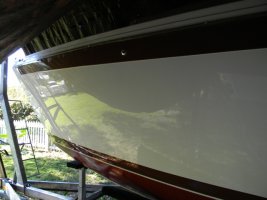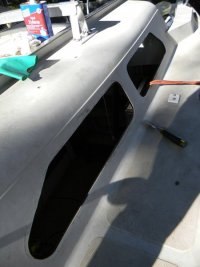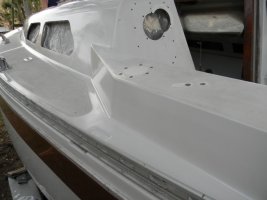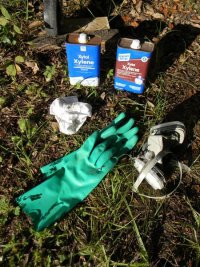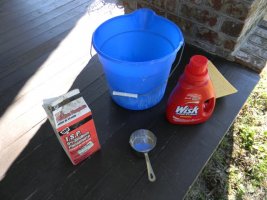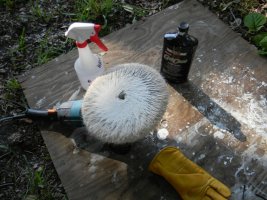Hello forum. I'm getting ready to yank my E29 out for the bottom paint thing. My question isn't about that but rather how to address the hairline cracks, mostly in the areas where the non slip is present but some in areas on the deck where it is not. I've not found any areas that are suspect to structural issues so maybe these cracks are more of a result of how the product was applied i.e. tempurature when applied and that type thing. Any feedback or advice for me?
You are using an out of date browser. It may not display this or other websites correctly.
You should upgrade or use an alternative browser.
You should upgrade or use an alternative browser.
Hairline cracks on non slip
- Thread starter Shu
- Start date
I was reading about this issue yesterday in Don Casey's "This Old Boat". It sounds like his answer, in the end, is paint. The gelcoat cracks either as result of flexion, or simply because it was a bit too thick in the mold.
The book, a manual of older-yacht rejuvenations, came recommended here, and maybe you already have it.
The book, a manual of older-yacht rejuvenations, came recommended here, and maybe you already have it.
davisr
Member III
I have the same types of cracks in numerous places on my deck. I value much of what I've read in Don Casey's This Old Boat. His method for fabricating new wooden handrails - a subject of recent discussion - was exactly what I used on my boat. I came very close to painting the deck of my boat for the reasons that Christian has just mentioned. I knew that I wanted to compound my hull (rather than paint it). I followed the steps that Maine Sail lays out in his sticky thread on Sailnet. I was able to bring the hull up to a high gloss finish. Having met success with this project, I decided to see what I could do with the buffer and compound on the deck itself. I was pleasantly surprised to hit upon nice results. The cracks still irritate me, but few people notice them since the deck itself glows. Maybe one day I'll paint the deck, but not any time soon. Oystercatcher is now 40 years old. Not bad, I would say.



Roscoe
Roscoe
Attachments
I have observed a couple of gel coat problems in boats older than, say, 1980. The long term UV damage finally causes enough of the coating wear away that the substrate is revealed or.... the opposite situation where the original gel coat was thick enough that continued curing and shrinkage over the decades has caused misc. cracks in the surface. We have an otherwise-excellent Ericson 29 in our moorage from the early 70's with thinning gel coat on the decks and cabin, for example.
For cracking from having the original surface sprayed on too thick while in the mold there are many Islander's from the 70's and early 80's with "alligatoring" all over the decks. It's been a well-known problem with the Islanders for many years.
So, depending on how that initial coat was sprayed in, this can happen to most any boat.
Solutions for the problem are what I am short of!

regards,
Loren
For cracking from having the original surface sprayed on too thick while in the mold there are many Islander's from the 70's and early 80's with "alligatoring" all over the decks. It's been a well-known problem with the Islanders for many years.
So, depending on how that initial coat was sprayed in, this can happen to most any boat.
Solutions for the problem are what I am short of!
regards,
Loren
Hairline cracks
I found a product called Captain Tolley's Creeping Crack Cure that I was considering. Anyone have experience with this goop? I guess at this point the possibility of moisture going through the freeze/thaw cycle and making its way deeper concerns me more that the visual of the cracks themselves.
I found a product called Captain Tolley's Creeping Crack Cure that I was considering. Anyone have experience with this goop? I guess at this point the possibility of moisture going through the freeze/thaw cycle and making its way deeper concerns me more that the visual of the cracks themselves.
Frank Langer
1984 Ericson 30+, Nanaimo, BC
I have used Captain Tolley's Creeping Crack Cure for a long time, but only as a preventive application around the base of stanchions, around window frames and similar areas where water could get in due to flexing and I want to keep it out. It is a white very thin liquid that dries almost clear, slightly bluish perhaps. It lasts a while but does degrade with UV over time. It could work in very light gelcoat cracks, though the "correct" fix is to widen the crack a bit with a dremel, fill with tinted epoxy or gelcoat, sand smooth, polish and wax til it's invisible. But that is alot of work and requires skill to fill correctly, not over or underfill, tint correctly and sand and polish just the right amount. But it's achievable with practice. 
Frank
Frank
davisr
Member III
Roscoe what did you use to get such beautiful results. Is the process reviewed on your Oystercatcher page. Could you point me in the right direction?
Thanks,
Kevin
Ericson 29
Michigan
Thanks Kevin. I used Don Casey's advice for cleaning the hull in general. I then, for problem areas, used Maine Sail's advice in terms of oxalic acid, i.e., Barkeeper's Friend. Once the hull appeared to be nice and clean, I followed Maine Sail's steps as outlined here: http://www.sailnet.com/forums/gear-maintenance/52772-tips-compound-polish-wax.html
I did, however, skip Maine's optional Step Five - Presta Chroma.
One thing I discovered was that I had to be more aggressive with the buffer to get the desired results. Maine warns against getting too aggressive, because it's easy to burn up the gel coat. There were a few spots on the deck, for example tight corners, where I came close to burning the gel. I was glad that I had done the hull first. I believe that if I had not gotten the hang of things on the hull, I would have screwed up the deck.
I've not yet had the time to write up my own article on my own experiences.
Regards,
Roscoe
Attachments
Thanks Frank. I'm thinking that I may use it now as a fix to hold me till early spring when I can tackle it correctly. Do you see a downside to that choice?I have used Captain Tolley's Creeping Crack Cure for a long time, but only as a preventive application around the base of stanchions, around window frames and similar areas where water could get in due to flexing and I want to keep it out. It is a white very thin liquid that dries almost clear, slightly bluish perhaps. It lasts a while but does degrade with UV over time. It could work in very light gelcoat cracks, though the "correct" fix is to widen the crack a bit with a dremel, fill with tinted epoxy or gelcoat, sand smooth, polish and wax til it's invisible. But that is alot of work and requires skill to fill correctly, not over or underfill, tint correctly and sand and polish just the right amount. But it's achievable with practice.
Frank
Frank Langer
1984 Ericson 30+, Nanaimo, BC
It would probably be fine as a stop gap measure till spring. I don't know of anything easy that would work better. Avoid silicone on gel coat.
Frank
Frank

